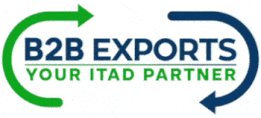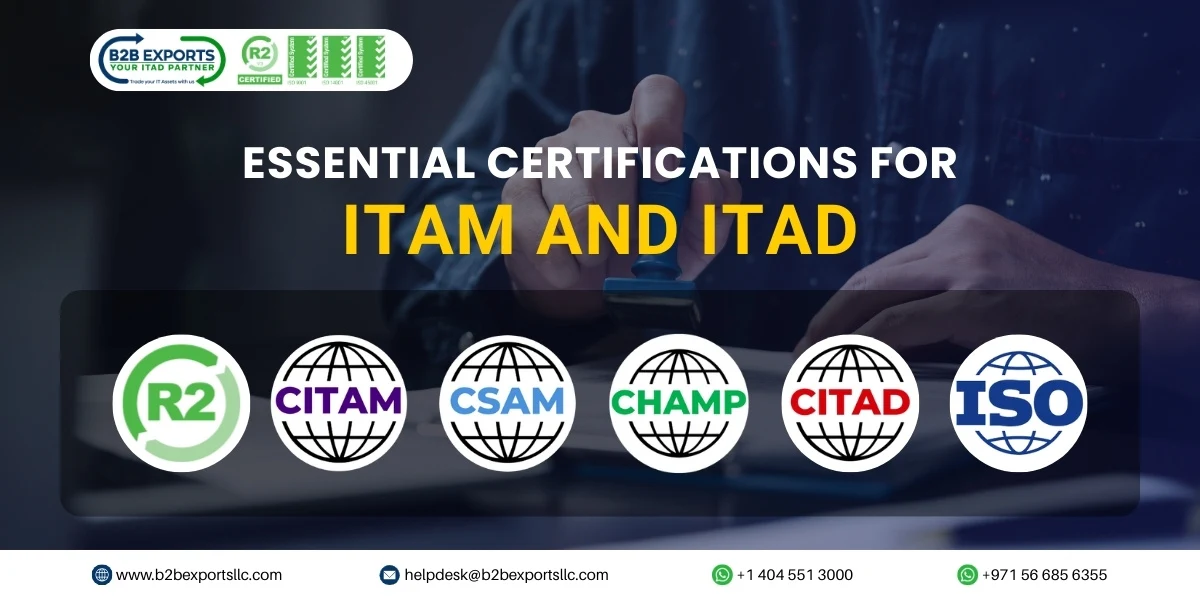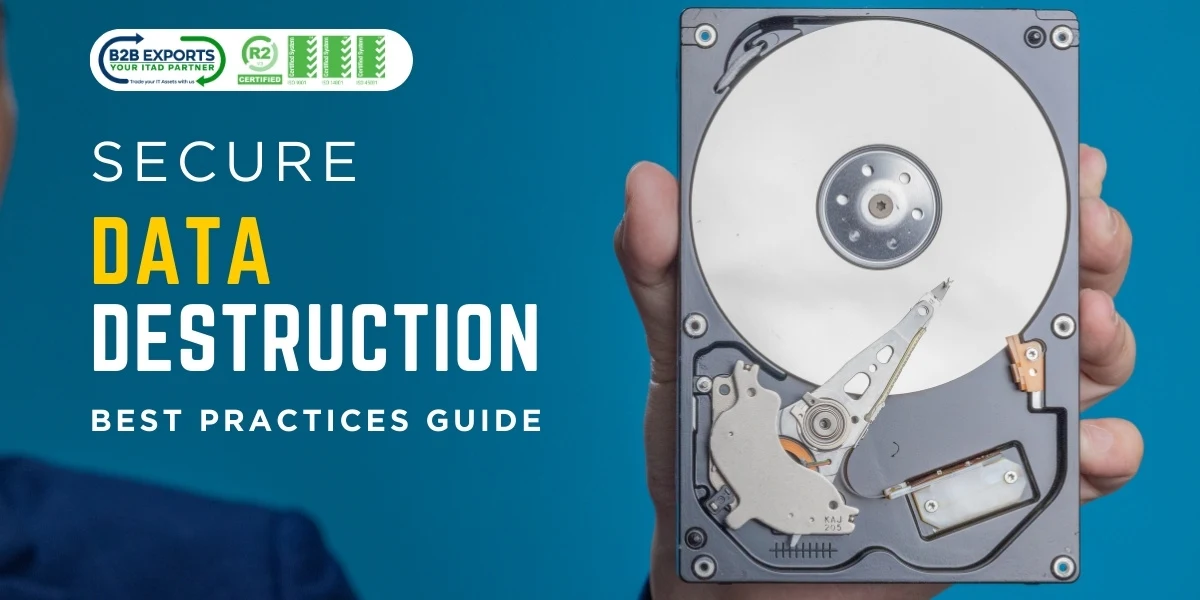The Ultimate Guide to IT Asset Management

The refurbished IT Asset market is booming, and it is very important to keep your IT Assets managed for the better efficiency of your organization. This is your ultimate guide to IT Asset Management (ITAM) from start to the end covering all the important topics like key Strategies, practices, benefits and the essential ITAM/ITAD certifications like R2V3, ISO27001 and ISO9001. ITAM ensures that each asset is properly utilized and maintained to increase the overall efficiency of the work culture. The primary objective of IT Asset Management is to minimize the cost and maximize the operational efficiency with an alignment to environmental sustainability.
IT Asset Management plays a fundamental role in the market, thus it needs a strong strategy to be implemented. A strong ITAM strategy involves Asset Lifecycle Management, Asset Tracking, Regular Audits, Asset Disposal, and Cost Optimization. It not only saves the cost but also helps in maximizing the assets utilizations. It plays a supportive role in providing real time assets’ insight and further contributing to the environment as well.
Let's have an eye on ITAM as a whole:
What is IT Asset Management (ITAM)?
Are your IT Assets managed? Ever had this question? If not, definitely you must.
IT Asset Management (ITAM) means managing IT Assets (Laptops, Desktops, Servers, etc.) using IT Asset Processes. It involves the devices and software's that the company owns, monitoring and performing repairs, upgrades or replacements of obsolete assets in the company, while complying with laws and legal certifications, such as R2V3 (Responsible Recycling Version 3) and other ISO Certifications.
All the companies in this universe handle their management over the internet to simplify their process and it is the company’s responsibility to manage the asset throughout its life. When the asset comes to the end of its lifespan, a company cannot just simply discard the asset, but it needs to be managed with utmost priority to both Data Security and Environment sustainability. This ensures that the assets are utilized to the full of their potential and disposed of at the right time.
When a company uses IT Asset Management services, it not only protects the company’s assets, but it also contributes to the environment sustainability and helps the needy person/organizations who really need the IT Assets. Every sector whether its private or public, needs various IT Assets and if they get it in their budget, it becomes very easy for them to buy these IT Assets. Thus, disposing of the asset is better than its disuse. IT Asset Management performs all the required processes from procurement to the disposition of the IT Assets while ensuring data security and making the environment e-waste free by remarketing, recycling and reusing the IT assets. It ensures that no asset remains unused, goes waste and the data in it remains confidential to avoid any misuses. Thus, ITAM is no longer an option, but a crucial responsibility.
Why is IT Asset Management important?

IT Asset Management is important because it brings clarity and control to an organization’s technological aspects. As an effective IT Management Solution, it helps track and manage assets throughout their lifecycle — reducing waste, saving costs and ensuring security. With IT Asset Management in place, businesses can make smarter decisions, stay compliant, and get the best value from their tech investments.
Here are a few key reasons why ITAM matters:
1. To keep track of the IT Assets:
ITAM is crucial for managing every device and software within a company, ensuring that no asset is damaged due to inactivity or negligence. ITAM provides proper management involving how many and by whom these IT assets are being used.
2. To Increase the Utility of IT Assets:
All the IT Assets come with a limited lifespan, making it very important to manage the health of every asset so that it should work properly and maximize output. Monitoring the health of your assets and providing services accordingly, including repairs, updates/upgrades and replacement, achieving better productivity.
3. Enhanced Data Security and Risk Management:
IT Asset Management becomes vital when it comes to Data confidentiality. It ensures that no data is leaked or falls into the wrong hands, managing the risk of data leakage and thus preventing any malicious activity, ITAM ensures that all these aspects are handled securely and systematically.
4. Promotes Sustainability and Reduces E-Waste:
ITAM minimizes E-Waste by not letting assets go into waste; instead, they are either disposed of or destroyed permanently if required, ensuring sustainability by recycling the assets, making the world a better place to live.
5. Maintaining Business Continuity:
ITAM helps businesses maintain continuity, allowing them to keep a clear inventory of their IT Assets, including their locations, condition and status. This ensures quick access to critical equipment in the event of an emergency.
The IT Asset Management Lifecycle:
ITAM is not a onetime process, instead it is a continuous process with a lifecycle focused on Asset visibility, optimization and secure retirement.
The IT Asset Management lifecycle goes as:
1.Planning and Procurement:
It involves setting strategies, budgeting, and acquiring IT Assets.
2.Deployment and Allocation:
It involves the installation and design of assets for employees or departments.
3. Monitoring and Maintenance:
It involves maintaining a record of all the assets assigned to different employees or departments.
4. Audit and Optimization:
It involves ensuring compliance, stating that everything is done legally with certifications like R2V3.
5. Decommissioning and Disposal:
It involves the erasing of data securely and systematically with data erasing processes like Wiping, Degaussing, Disposing, and Destruction.
IT Asset Management Process:
ITAM involves a list of various processes to be carried out to make it a structured and goal-oriented procedure. Process involves the first stage to the final stage of the asset.
The IT Asset management process goes like:
1. Asset discovery and inventory
2.Asset Procurement
3. Asset Deployment
4. Asset Usage
5. Asset Maintenance
6. Asset Transfer
7. License Management
8. Audit and Compliance
9. Cost Tracking
10. Disposition
Benefits Of IT Asset Management:
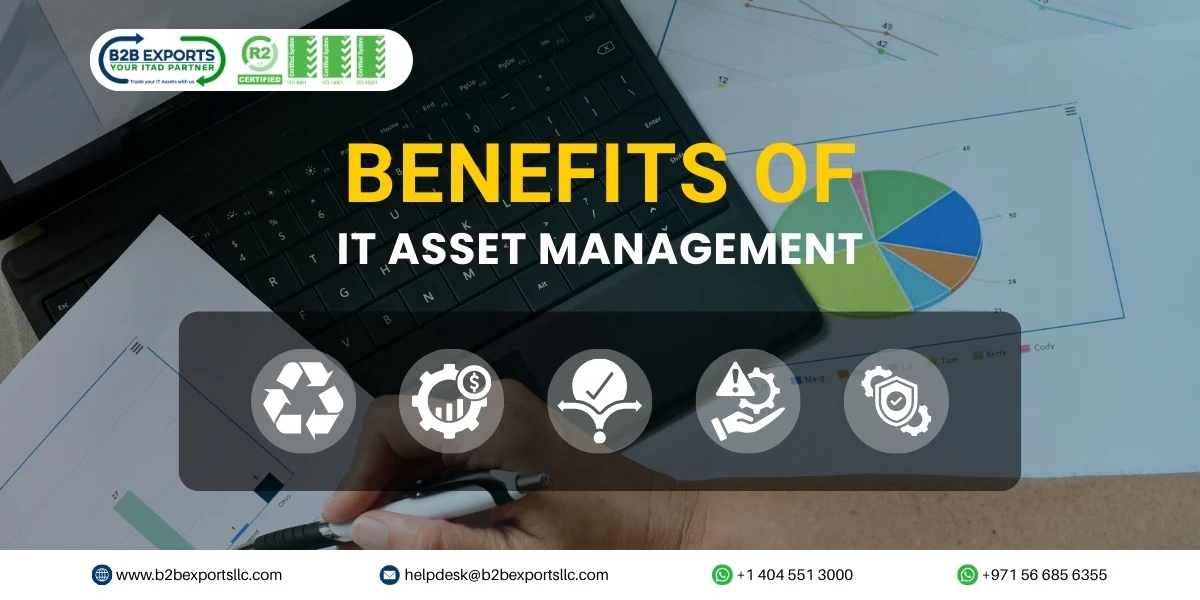
1. Cost Optimization and Asset Utilization:
In industries like ITAM, IT assets are heavily used as the whole industry runs on these IT Assets whether they are Laptops, Desktops, servers or other IT assets. It becomes more crucial when it comes to maintaining them so that no assets can be overutilized or left unused for a long period of time. IT Asset Management keeps an eye on every asset in the company to optimize the expenditure cost and increase utilization.
2. Improved Compliance and Risk Management:
ITAM helps businesses run seamlessly by providing a record of every IT asset in the company, mentioning the usage of the asset which helps businesses avoid heavy legal fines over their unused assets. It also reduces the risk of data leaks by providing ITAM solutions like Disposition and Destruction according to the condition of the asset. Helping businesses stay safe and legally stable. Thus, it also contributes to the environment by not letting assets go to waste.
3. Increased system reliability and Optimized Productivity:
ITAM keeps a track of each asset in the company so that all the assets in the company be used to their full potential by the employees rather than wasting the maximum time in the repairment of the assets which will ultimately increase the company’s productivity and the help the business grow rapidly and sustainably.
4. Secured and Responsible Asset Disposal:
When IT assets become obsolete, it becomes important to dispose of them on time with a responsibility of protecting both the Data and the environment. IT Asset Management includes the disposition of obsolete assets with a promised priority to keep the data safe and reduce E-Waste by Reselling and Recycling the asset properly.
5. Better decision-making with real time data:
With proper ITAM, organizations gain access to real-time insights about their IT assets. This up-to-date information empowers teams to make smarter and faster decisions about company operations rather than relying on outdated reports. Thus, eventually it helps businesses to get better outputs and ensure profitability.
IT Asset Management Strategies:
IT Asset Management involves various strategies to be followed by an organization. Strategies give a clear vision about the important steps that should be followed to ensure a proper and goal-oriented result in IT asset management.
Let us see some important strategies:
1. Asset Lifecycle Management:
Managing an asset's lifespan properly, from installation to their disposal keeps track of each stage of an asset's lifespan and determines when it has to be disposed of.
2. Centralized Asset Tracking:
Keep all IT asset data in a proper way that can be easily managed and shows the asset details like type, owner, location and status of the asset.
3. Regular Audits:
Regular audits are done to check and verify the IT assets of an organization. This answers the questions, Are the assets properly tracked, are they functionally performing well, any data leaks, or any updating is required.
4. Data Security and proper disposal:
There should be proper disposal of the assets. Proper disposal simply means safe, secure and environment friendly disposal of the unused or aged IT Assets.
5. Minimizing cost and maximizing utilization:
It involves minimizing the company’s expenses in the repairment of the IT assets which are no longer needed. There may be some IT assets which are not being used to their full potential, should be tracked and be ready to be used resulting in maximizing the company’s utilization.
IT Asset Management Best Practices:
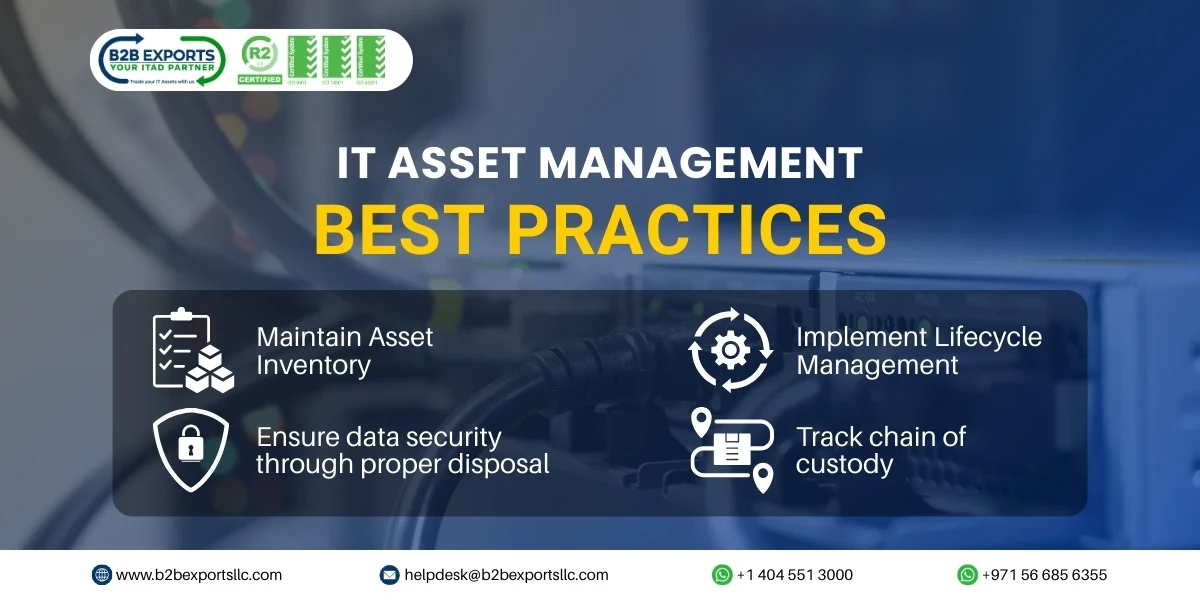
Now, once an organization has the IT Asset Management strategies it should apply the best IT Asset Management practices to keep an eye over every asset in the organization, manage and utilize them to their full potential.
Let us understand some important IT Asset Management practices:
1. Maintain Asset Inventory:
IT inventory tracking involves keeping a real time database of all the IT assets, tracking the details like type, owner, location, status, serial number and lifecycle stage of the IT assets. Asset inventory helps in reviewing and verifying the condition of the IT assets and the budget finalizing when assets are set for disposition.
2. Implement Lifecycle Management:
It involves management of the assets from their installation to their disposal. The complete process goes like procurement, usage, retirement, and disposal. It helps in cost saving, better outputs from the assets and timely updating of these assets.
3. Ensure data security through proper disposal:
It ensures the proper disposal of the IT asset keeping in mind that data remains secured and there is no harm to the environment. Also ensures proper certification of data erasure or physical destruction to comply with laws ensuring that all the work done is legal.
4. Track chain of custody:
Chain of custody simply means keeping a record of asset from beginning to the end using barcodes and digital tracking tools. Thus, building trust among clients and meeting certification standards of the industry.
5.Stay compliant with industry regulations:
There are heavy fines and penalties when a company doesn’t meet industry standards of following data erasing certifications, or data protection certifications. It also affects the company’s reputation, making the company untrustable. Thus, it is important to stay compliant with industry regulations.
Types Of IT Asset Management:
1. Hardware Asset Management:
Keeping track of all the hardware IT assets in the company such as Laptops, Desktops, Servers, Printers, Scanners and Power Equipment's to maintain the utility of these hardware devices and providing repairment when needed. It helps the system keep working properly.
2. Software Asset Management:
This part of IT Asset Management includes management of the software IT assets such as Operating Systems, Productivity Software, Enterprise Software, Security Software and Development tools by keeping a record of each software ensuring to provide the right updating and changing the software if needed.
3. Cloud Asset Management:
All the companies manage to have Cloud storage (like Google Drive, AWS or Microsoft Azure) in today's smart technical world. It is important to keep stored data managed and secure, maintaining the confidentiality of the data stored so that only the right person can access the right data with a security pin. Thus, it becomes important to keep the stored data safe and secure, ensuring its proper management.
4. Digital Asset Management:
As all the important information, documents and files of the organization are stored digitally, managing the information to keep it safe becomes significant. So that no unauthorized person can log in and misuse the data. Thus, it is effectively managed through ITAM.
IT Asset Management Solutions:
In today's digital world, all organizations have moved to the internet and store their entire data online to work smarter and faster. All these IT assets come with a limited life and need solutions as per their requirements. Major solutions that lie under the IT Asset Management process are Disposition and Destruction.
Let's understand them:
1. IT Asset Disposition (ITAD):
IT Asset Disposition is one of the most used IT Asset Management strategies for the removal of the used and aged IT Assets that are no longer in use, ensuring proper certifications of erasing the data in a way that there is no data breach. Every IT asset that is no longer needed and has unnecessary space within the organization should be disposed of safely.
ITAD includes Reselling, Recycling and Destruction (permanent removal of the asset). All these aspects of ITAD are processed while ensuring complete Data Security, Environmental Safety and Regulatory Compliance.
2. IT Asset Destruction:
Disposition refers to the method of permanently destroying the asset to erase the sensitive or confidential data it might contain whereas Destruction is only brought into action when the retired asset either includes confidential data, or the asset is beyond repair or reuse. The whole process is done legally, with a Certification of Destruction (CoD).
Destruction includes Degaussing, Data Wiping and Physical Destruction.
Let's Understand these processes one by one:
1. Degaussing:
Degaussing is an extreme process of using high-powered magnetic fields for the permanent erasing of confidential data stored on magnetic storage devices like hard drives or tapes. It destroys the data permanently in a way that the Data is irrecoverable. Thus, it saves confidential information stored on the device.
2. Data Wiping:
It is another method that is used for the erasure of the data from the asset in a way that the asset is still reusable, but the removed data cannot be retrieved again to maintain the confidentiality of the data. The complete process is done with the software programs that are designed for this purpose only.
3. Physical Destruction:
This is the final process of the disposition of IT Asset. This process of destruction is mainly done by hardware shredding, which means physically destroying hard drives by cutting them into tiny pieces so that the data becomes impossible to retrieve and assures secure Asset disposal.
Why Disposition and Destruction?
When IT Assets come to the end of their life, they cannot be discarded unjustifiably; rather, they should be disposed of safely and legally, with proper data erasing certifications and a promising contribution to the sustainable environment by reducing E-Waste.
Disposing of the unused assets is pivotal to:
1. Prevent data breaches
2. Reduce legal and environmental risks
3. Comply with data protection laws (like GDPR, HIPAA, etc.)
4. Optimize space and Resources
Essential Certifications for ITAM and ITAD:
When things are done legally and systematically, there are fewer chances of operation inefficiency. IT Asset Management follows proper rules and regulations to ensure that the complete management of these assets is done systematically under the supervision of experts and certified authorities like SERI. The important certifications are as follows:
1. R2 (Responsible Recycling) Certifications:
R2 certification plays a vital role in the disposition of obsolete IT Assets. All the companies that deal in the disposition of IT Assets need to be R2 certified to be a trusted company in the ITAD industry, ensuring the disposition of the assets is done safely, legally and environmentally friendly. The current version of R2 certification is Version 3 i.e. R2V3. The R2 certification is issued by SERI (Sustainable Electronics Recycling International), which sets R2 standards from secure data removal to environmental protection.
2. Certified IT Asset Manager (CITAM):
This is one of the most important certifications in the ITAM world. This certification is issued for IT Asset Strategies, Lifecycle, Compliance, and Value Optimization.
3. Certified Software Asset Management (CSAM):
This certification is a critical part of ITAM as it is designed for Software Licensing, Audit checks and Compliance.
4. Certified Hardware Asset Management Professional (CHAMP):
This certification is important to ensure physical Asset Tracking, Lifecycle Management and to optimize all the hardware investments.
5. Certified IT Asset Disposition (CITAD):
This certification is strongly applicable for the certified IT Asset Management Companies that deal in the disposition of obsolete IT Assets securely and environmentally friendly manner.
6. ISO 27001:
This certification states that an organization meets the standards of ISMS (International Security Management System) set for Information Security, saying that the organization follows the best IT Asset Management practices to keep the data secure when performing the IT Asset Disposition. The benefits of this certification include Enhanced Data Security, Increased Trust of the customers, Competitive Advantage, Regulatory Compliance and Reduced Risk of Data breach.
7. ISO 9001:
This certification is important to check the quality Management, sets the standard for meeting the requirements of the customers and maintaining consistency in it. Thus, achieving this certification shows commitment to quality, increased efficiency and Customer Satisfaction.
Refurbished IT Market is Rising: We were growing, we are growing, & We will grow
The refurbished IT market has caught fire, what? Yeah, you heard it right. According to a report, the market will touch USD 21.7 billion by the end of 2025 and is likely to boom with USD 57.3B by 2035 mentioning which shows a growth rate of over 10% every year. This rapid rise has only been possible with the rapid increase in technology.
Laptops lead the market with 74%:
The most reused assets in the market are laptops, dominating the market with a 74% share. It says that reused laptops are more affordable and can be used again to their maximum potential.
Windows are no less:
Windows laptops also lead the market with over 66% share. All the organizations that use desktops, whether they are Schools/Colleges or Hospitals/Airports, prefer refurbished windows just to provide better quality at an optimized cost.
E-Waste Reduction, Sustainability and Cost Saving:
No doubt IT Asset Management /IT Asset Disposition has a vital role in contributing to the environment by disposal of unused IT Assets, preventing both the data and the environment from successfully disposing of these assets. It helps businesses reduce their costs by providing better recycled assets rather than paying a huge amount for a new asset. Both private and public sectors can scale their businesses cost effectively.
